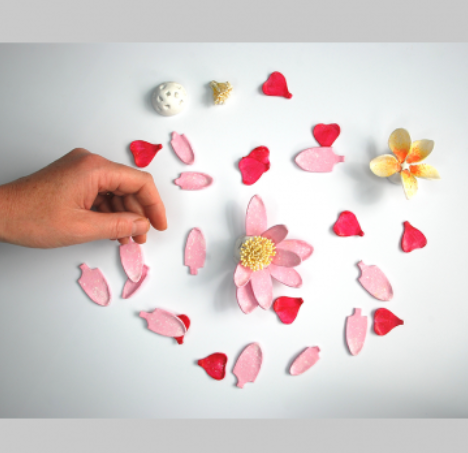The therapy tool, called Blossom, was designed by Orlando after two close family members suffered strokes and, as part of the rehabilitation process, required a tool to improve and practice their fine motor skills in a creative and engaging way.
He is now developing a 3D-printed prototype of the nature-inspired product in collaboration with the National Manufacturing Institute Scotland (NMIS), operated by the University of Strathclyde and part of the High Value Manufacturing (HVM) Catapult, which has been tested in clinical consultation and by users from dementia groups. The project was also supported with £15,000 of funding from Innovate UK.
Blossom is a hand-held therapy device featuring three buildable flowers designed to challenge fine motor skills and enhance cognitive function. Users can practice arranging the petals and stamen, with each flower increasing in difficulty. Its design, incorporating various petal layouts, encourages users to engage both hands and utilise 16 different pinch and grasp exercises. Blossom uniquely offers the evidence-based benefits of patterns, a re-connection with nature, and a creative outlet, all of which boost mood and motivation.
The NMIS Design Engineering and Additive Manufacturing teams provided comprehensive support to Orlando, transforming his vision into a viable product through detailed 3D modelling to optimise the design. This included evaluating and selecting appropriate materials and manufacturing processes to achieve the desired appearance and functional requirements.
Various manufacturing techniques were evaluated, including injection moulding and additive manufacturing processes like Powder Bed Fusion (PBF) and Material Extrusion (MEX). PBF proved most suitable because of its ability to produce strong, durable, and complex parts with a textured finish, which is crucial for the tool’s usability.
Additionally, the team introduced design enhancements like a dimple fastening method to further elevate the sensory experience. The 3D printed prototypes of the developed design have allowed Orlando to engage in further user testing and gain feedback on the changes and selection of manufacturing method.
Orlando Ely said: “With assistance from NMIS to evaluate different manufacturing methods, I’m now well positioned to approach a partner that can manufacture the product at scale. Based on user feedback, my next phase will focus on refining the design, enhancing aesthetic appearance, and expanding the range of therapeutic applications.
“Blossom’s nature-inspired design sets it apart from other therapy tools on the market, which can sometimes appear juvenile. The tool combines the beauty of flowers and their phyllotactic patterns – the regular arrangement of leaves and petals on a plant stem – providing both cognitive and sensory stimulation. This activates brain regions associated with reward, encouraging repeated use, essential to the tool’s effectiveness. The design offers a fresh, versatile approach to this kind of repetitive, but essential, therapy.
“So many people could benefit from Blossom. A sense that life is worth living is key to people getting better and I believe that Blossom can help with this.”
Pritty Mathew, Assistant Design Engineer at NMIS, said, “Working with Orlando to bring Blossom to life has been inspiring. It exemplifies how innovative ideas, combined with advanced manufacturing technologies, can lead to new products that make a real difference.
“This collaboration underscores our role in assisting growing businesses to get the best from their future manufacturing partners by identifying optimal approaches and materials. Orlando first created this device using an at-home 3D printer, and now, with our support, it can be developed for commercial scale production. It’s projects like these that showcase the practical benefits of modern manufacturing techniques and highlight the potential for significant improvements they can make to patient recovery solutions.”
Original article source:
FAQ
- What are the benefits of 3D printing for developing therapy devices?
– Rapid Prototyping: 3D printing allows entrepreneurs to quickly create prototypes of their therapy devices, enabling them to test and refine their designs in a cost-effective manner.
– Customization: 3D printing enables the production of customized therapy devices tailored to the specific needs of individual patients, enhancing comfort and effectiveness.
– Reduced Costs: Traditional manufacturing methods can be costly for small-scale production runs. 3D printing reduces initial costs and eliminates the need for expensive molds or tooling.
- How does 3D printing support innovation in therapy device development?
– Design Flexibility: Entrepreneurs can experiment with complex geometries and unique designs that may not be possible with traditional manufacturing.
– Iterative Development: 3D printing allows for continuous iteration and improvement of designs based on user feedback and clinical trials.
- What materials are used for 3D printing therapy devices?
– Various materials can be used, including biocompatible plastics, resins, silicones, and even metal alloys. The choice of material depends on the specific application, whether it’s for soft tissue support, bone replacement, or other therapeutic uses.
- Can 3D printing make the manufacturing process faster?
– Yes, 3D printing significantly speeds up the manufacturing process. Devices that might take weeks or months to manufacture using traditional methods can be created in a matter of days or even hours with 3D printing.
- What role does 3D printing play in the scalability of therapy devices?
– 3D printing allows entrepreneurs to scale production as demand grows without the need for large capital investments in traditional manufacturing facilities. This flexibility helps in responding to market demand more effectively.
- How does 3D printing help in reducing environmental impact?
– 3D printing is often more sustainable than traditional manufacturing because it uses only the necessary amount of material, reducing waste. Additionally, on-demand production reduces the need for large inventories, further lowering waste and energy consumption.
- What are some challenges associated with 3D printing therapy devices?
– Regulatory Compliance: Therapy devices, especially those used in medical applications, need to meet stringent regulatory standards. Ensuring compliance can be challenging.
– Material Limitations: Not all materials are suitable for all types of therapy devices, and some may require additional testing for safety and efficacy.
– Post-Processing Requirements: Some 3D-printed parts may require additional post-processing, such as smoothing, painting, or sterilization, which can add time and cost to the process.
